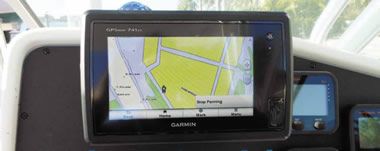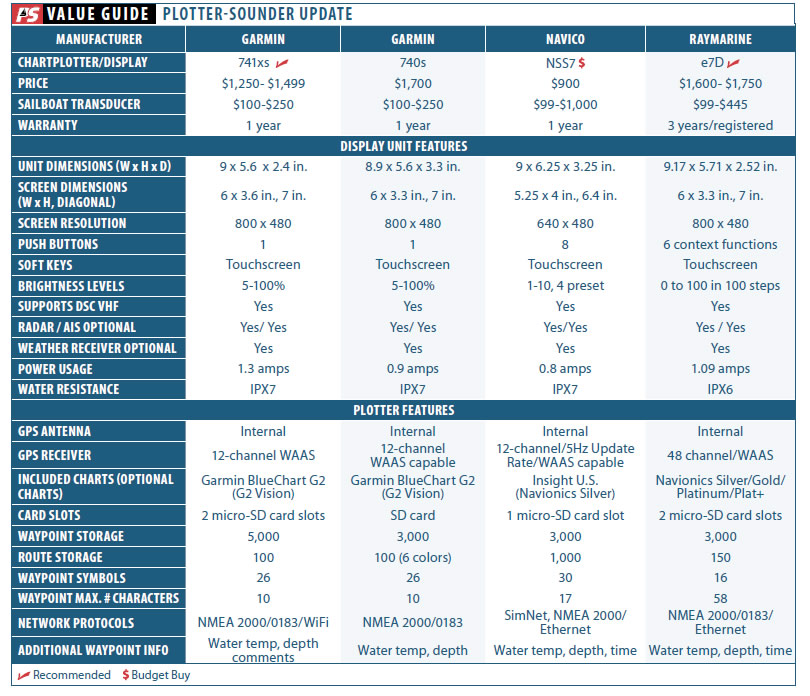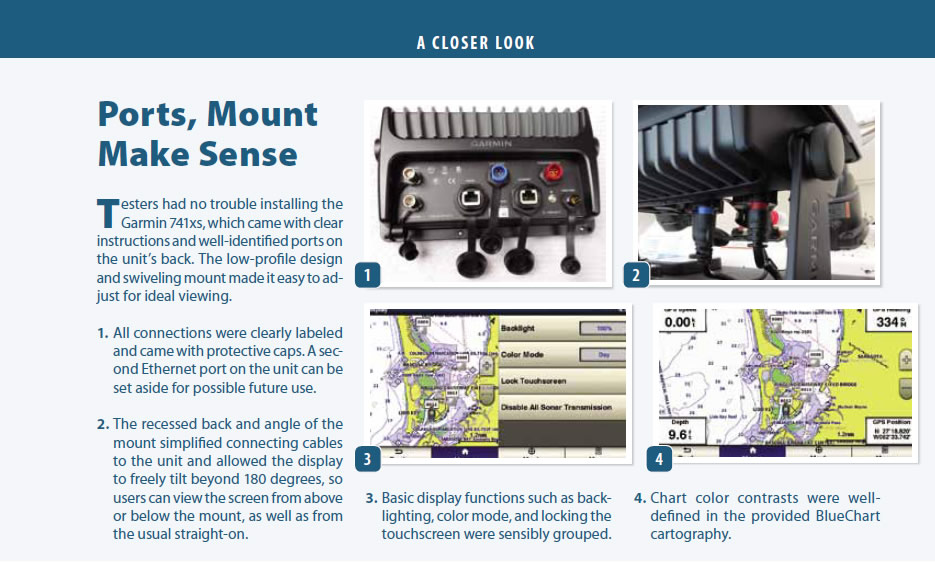
Photos by Frank Lanier
Planned obsolescence is probably the most irksome way to keep manufacturing costs down and inspire us to buy stuff. Each time a new or updated line of multi-function devices appear, we ask ourselves if the new version represents real value, or are the engineers just adding another tower to their Lego castle, while the marketing folks ponder adding an umlaut or X to the product name.
This month, we look at new multifunction displays from Garmin and Raymarine, and each manufacturers distinct approach offers a window into the world of product upgrades.
Back in 2012 (see PS July 2012 online), we looked at the Garmin 740s, the predecessor to the more recently introduced 741xs. At that time, we compared it with the Raymarine e7D, which we review again this month, but now it has upgraded features. (See accompanying article.) In November 2012, we compared both the Garmin and the Raymarine multifunction displays with the Simrad NSS7.
The flurry of new launches began around 2007, when Garmin mainstreamed the touchscreen chartplotter; soon after, all the makers were on board. All of the new plotters were looking at represent a continued attempt to perfect the touchscreen interface.
Despite the advantages of durability, were still wary of touchscreens. Early versions werent as bright as standard chartplotters, they attracted fingerprints, and testers found them more difficult to scroll, zoom, and navigate on a boat while underway. But since most people are rarely surfing their chartplotters, the waterproof ruggedness of the touchscreen interface earned our respect. Since that 2012 review, weve looked closely at two different Garmin 741xs models, as well as the new Lighthouse firmware in the Raymarine e7D.
What we tested
For this article, we tested two current versions of the Garmin 741xs. We lab-tested one unit in conjunction with our wind-instrument testing series, and testers installed the other one in a 27-foot, outboard-powered catamaran. The power-boat system included both a traditional 50/200 kHz through-hull transducer and the new Garmin GCV 10 sounder module with the transom-mounted, side-scan transducer. We also will be installing a 741xs aboard a 40-foot ketch-rigged sailboat with the new Garmin Gwind N2K twin-vane wind transducer and its GND10 interface box. The boat installations are being carried out by Sarasota, Fla.-based marine technician Bill Bishop, and the boats owners have generously allowed us to use their systems for testing.
How we tested
Our testing examined installation complexity, system intuitiveness, display visibility, and its features. We compared the test results of the new 741xs with those of the 740s. The 741xs is rated for IPX7 water-resistance (immersion to 3 feet for 30 minutes). We have not yet performed a full wet test on the unit because we still need it for further wind-sensor testing.
Installation of both 741xs units used Garmins supplied mounting bracket. One unit was mounted on our test setup, and the other installed vertically in a test boat.
Installation: Testers used the included instructions and templates for both installations, and found all the parts were in order and directions were explained well.
Screen visibility: Screen visibility ratings were given in bright sunlight (with and without polarized sunglasses), at night, and in the shade. Testers viewed the screens from different angles along with night lighting and available display color palette.
Ease of use: Testers evaluated touchscreen operation, setting and using waypoints and routes, menu structures and clarity of documentation.
Sounder: Sounder functionality was subjectively examined. Water clarity was good, and water temperatures were in the low 70s. Both traditional (50/200 kHz) and CHIRP down- and side-scan sonar testing took place in Sarasota Bay, Fla.
Garmin 741xs
The 741xs has the same new user interface as the Garmin 8000 Glass Helm system. One notable change from the 740s is that the older touchscreen systems had a fixed Home page with major elements such as charts, sonar, and radar. The new user interface allows users to customize the home page for quick access to specific screen configurations. This reduces the number of touches needed to access your most-often used pages.
Like the 740s, the 741xs design is a standalone product with built-in sounder and radar support. So, although there is NMEA 2000 data connectivity between 741xs MFDs, the radar and sounder data will not transfer from one unit to another on the Garmin Marine Network. There is a second Ethernet port on the unit assigned for possible future use. Like the older 740s, the 741xs retains the capability to transfer waypoints on the NMEA 2000 network to another Garmin display in the network.
The other significant change to this MFD is the addition of WiFi and Bluetooth capabilities. Apps such as Garmins iOS-based Glass Helm for remote control and BlueChart Mobile for route planning are now fully supported. NMEA 2000 data streaming to the Quatix watch (see PS Chandlery August 2013 online) from a 741xs requires the addition of Garmins GNT10 transceiver ($200) to the N2K network. The Quatix watch also can connect to Garmins BlueChart Mobile.
Installation: The 741xs can be flush or bracket mounted. The sturdy, black-plastic mount has four fastener holes with a central hollow base and preformed individual wire slots on the back of the mount.
Since the 741xs is thinner than the 740s and comes with low-profile cable fittings, it will rotate well past 90 degrees through the mount. This design opens up more flexibility when bracket mounting and allows for attachment on a vertical surface, which is how we mounted it on the test boat. While sitting at the helm, the unit can face aft for viewing, and when standing, users can rotate it up to view it from above.
Installation is largely plug-and-play with color-coded connectors and clear instructions. The only two issues testers had were the ball-shaped mounting bolts, which are a touch too short, often requiring them to be removed completely to release the unit from the bracket, and the micro SD cards may require a small pair of needle-nose pliers or tweezers to remove. Our testers fingers had trouble getting a good grip on the little chips.
Screen visibility: The WVGA touchscreen displays 800 x 480 resolution doesn’t appear to have changed from the 740s to the 741xs, with the exception of adding the iOS-style pinch-to-zoom capability. Color palates and back lighting are still the same with a photocell that automatically adjusts the back lighting to ambient light. Backlighting can also be manually adjusted. The touchscreen calibration feature, which weve never needed to use, is now available directly through the menus rather than a special powering-up sequence. Screen visibility is good over a large range of angles (up to 45 degrees), and the display viewability is largely unaffected by wearing polarized glasses.
Ease of use: The Garmin touchscreen menus are intuitive and sensibly limited to the modules (depth, weather, etc.) you have installed. This reduces the number of options to search through to find the screen youre looking for. For example, if you don’t have a weather module, you don’t see the weather-related menus. When you touch the chart display, the options that are available immediately appear.
Users initial choices are to navigate to where you touched, get information about tides and currents or points of information, measure range and bearing from that spot, or make a waypoint. The new customizable home page eases user access to the most commonly used pages. There is also a strong suite of wind-related pages with lots of customization possible.
The manual has shrunk from the 740ss 93-page tome to the 741xs version with 33 pages. It is understandable and well organized, but very brief.
Mapping: Garmins BlueChart cartography is a standard in most Garmin units, and the 741xs also comes with a separate Garmin LakeV HD chart chip covering over 17,000 U.S. lakes which will be an asset to lake sailors. The optional G2Vision chips providing more points of information and photos are also supported.
Sounder: The advancement in sonar technology was most evident in the 741xss new capabilities. With the new sonar receiver, there is a distinct improvement in the 50/200 kHz portion of the system when compared to the older 740s. By adding the new Garmin GCV 10 CHIRP DownV and SideV sonars, you can have photographic-like images of the bottom.
New features include the ability to record sonar images, and play them back on Home Port software or an iOS mobile device. You can also set a waypoint by touching any feature you see on the sonar bottom display. Although these features are clearly designed with fishermen in mind, we can see them being useful for sailors in poorly charted areas who want to follow bottom contours.
Bottom line: We have reservations about systems in which every navigational feature is dependent on one display, but if you have backup tools available, and prefer a single-station chartplotter system, the Garmin 741xs is hard to beat-both in price ($1,500 average price online) and capabilities. Wireless capabilities represent a meaningful upgrade, especially for the tech-savvy sailor. On the downside, current draw increases slightly.
The 740xss size and mounting flexibility offer better-than-average helm-mounting options. Radar, AIS, video, satellite weather touchscreen, wireless capabilities, and wind transducer displays are the equal of larger systems. Both traditional 50/200 kHz, and CHIRP transducers plug and play into the built-in sounder module. The Garmin GCV 10 side/down scanning technology is available as an option. We found that the Garmin 740xs offered a lot of excellent technology, was user-friendly, and a very good choice for sailors-especially those already committed to the Garmin brand.






































